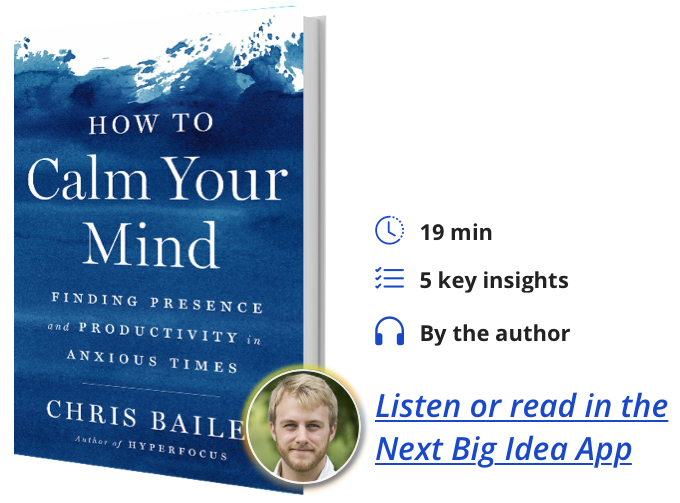Chris Bailey is a productivity consultant and writer. His writing about productivity and focus has been published in The New York Times, The Wall Street Journal, GQ, Huffington Post, New York Magazine, Harvard Business Review, TED, Fast Company, and Lifehacker.
Below, Chris shares 5 key insights from his new book, How to Calm Your Mind: Finding Presence and Productivity in Anxious Times. Listen to the audio version—read by Chris himself—in the Next Big Idea App.

1. Take notice of how much of our life orbits around dopamine.
Dopamine is a neurochemical that’s pretty misunderstood. It’s often thought of as a pleasure chemical, but in truth, dopamine supports us in pretty much everything that we do. It helps us to think logically and creatively.
The chemical also has somewhat of a darker side: it’s released in our brain whenever we tend to something stimulating and novel. In fact, the more novel an experience is, the more dopamine that gets released in our brain. Researchers call this our brain’s “novelty bias.” The problem here is that dopamine leads us to feel as though pleasure is on the way. The chemical leads us to feel a sense of anticipation rather than pleasure. And here’s the thing: this sense of anticipation propels us forward into distracting ourselves further. In this way, dopamine creates a cycle of distraction: dopamine begets dopamine, stimulation begets stimulation, and distraction begets distraction.
Notice how much of the day you have the desire to stimulate your mind. Also notice what you crave more of, especially traditional measures of success like financial success, power, and accomplishment. There’s obviously nothing wrong with having goals and wanting to accomplish more! However, this “acquisition mentality” is typically propelled forward by dopamine. The more of our behavior that’s motivated by dopamine, the less present and calm we become—and this can lead us to greater anxiety and less focus when we’re not careful. It might sound odd that becoming more driven can make us less productive, but in a lot of cases, because of dopamine, this happens to be true.
2. Conduct a stimulation fast.
Because dopamine is a neurochemical that is involved in so many of the things we do every day, we can’t fast from dopamine any more than we can fast from carbohydrates (on a chemical level). What we can fast from are empty hits of dopamine that we engage in primarily for the dopamine release itself. We can do this through a stimulation fast. The more common term for a stimulation fast is a “dopamine fast,” which is a misnomer because dopamine is involved in so many of our body and minds’ processes.
“What we can fast from are empty hits of dopamine that we engage in primarily for the dopamine release itself.”
To conduct a stimulation fast, start by identifying the dopamine-driven activities and distractions you want to weed out of your day. Especially look to the most distracting and threatening sources of distraction that you tend to: the digital news, the websites you refresh, the social media websites to tend to use out of habit, and the games on your phone that lead you to waste a good amount of time, like Candy Crush and my personal favorite, Subway Surfers. Then, identify some well-rounded activities—preferably ones that exist in the analog world rather than the digital one. Substitute in these activities for the digital ones. For example, you can pick up an old musical instrument you haven’t touched in a while, you can volunteer, or you can read more physical books. Once you’ve identified some substitute activities, choose a duration for the fast.
3. Understand the six triggers of burnout.
Exposure to chronic stress can be costly. When we face too much of it in our days, we can become anxious and less calm. This makes us less focused, present, and productive. Chronic stress—stress that we face repeatedly that doesn’t seem to have an end in sight—can also lead us to another devastating condition: burnout. Burnout is a psychological condition that is defined as having three characteristics, and we need all three in order to be fully burnt out. First of all, we need to feel exhausted. Second, we need to feel cynical. Finally, we need to feel ineffective, convinced that how we’re spending our time and attention and energy doesn’t make a difference. If you’re feeling just one of these three characteristics, that could be a sign that you’re facing too much stress and that you’re on your way to being burnt out.
Traditionally, burnout has been defined as an occupational phenomenon, something that occurs at work, and not at home. These days, of course, when the boundaries between our work and our personal lives have become blurred, stress can come in from any area of our life. Luckily, it’s relatively easy to zero in on where our work stress comes from. Research points to six areas of our work where work stress tends to metastasize. If you’re feeling any combination of those three burnout attributes—exhausted, cynical, and unproductive—these are six areas of your work that you need to dissect to understand where your stress is coming from.
The first trigger of the six is workload: the more work we have on our plate, the more likely we are to burnout. The second is a lack of control: the less control we have over how, when, and where we do our work, the more likely we are to burnout. The third area of our work where stress tends to grow is with insufficient reward. The less fairly we’re rewarded, the more stress we face from our work and the more likely we are to burn out. This can relate to how fairly we are compensated financially, but also extends to social recognition, whether we’re recognized for the contributions that we make or not, or if we find our work meaningful in the first place.
“Dissect what is broken about your work, and use whatever autonomy you have to make a plan to remedy your situation.”
The fourth area stress can grow in is in a lack of community at work: when we don’t feel connected with those we work closely with we’re more likely to reach a point of burnout. The fifth factor is fairness: we need to be treated fairly relative to others at the office in order to be motivated. The sixth factor is our values. We find our work more meaningful when we can connect how are spending our time with what we value on a deeper level. Understanding your values is also a great way of uncovering more about who you are.
If you’re feeling some combination of exhausted, cynical or unproductive at work—and beyond—look to these six areas: workload, lack of control, insufficient reward, community, fairness, and values. Dissect what is broken about your work, and use whatever autonomy you have to make a plan to remedy your situation.
4. We find greater depths of calm in the analog world compared to the digital one.
Curiously, the analog and digital worlds influence our state of mind in vastly different ways. For starters, the digital world is built around novelty, which means it releases far more dopamine when we tend to it. Comparably, the analog world leads us to experience the effects of other neurochemicals that make us feel present, connected with others, and proud—chemicals like oxytocin, serotonin, and endorphins.
One way to connect more deeply with the analog world is to break down the activities you do in both worlds. We can do this by making a Venn diagram of activities we do in each world. In this case, our Venn diagram has two circles: one for our analog-only activities, like brushing our teeth and spending time in nature, and another circle for our digital-only activities, like checking social media and answering email. Where these two circles overlap are the activities we can do in both worlds: writing, maintaining a to-do list, spending time with friends, reading good books, playing games with friends, and consuming news are all examples of activities we can do in both.
One simple rule for finding more of a balance between these two worlds is this: when you want to do something efficiently, do it in the digital world. When you want an experience to have more meaning, do it in the analog world. This is a simple rule, but it helps to divide up the tasks done in both worlds.
“If anxiety is found in the digital world, calm is found in the analog.”
Over time, bring more of these activities into the analog world. Instead of journaling digitally, sit down with a coffee and break out a pen and a sheet of paper. Instead of playing a simple game on my phone, play a board game with your partner or a group of friends if they’re around. Instead of refreshing news in the digital world, start reading the physical newspaper every morning.
If anxiety is found in the digital world, calm is found in the analog. Remember that researchers have found that anxiety is the opposite of calm—and that experiencing any level of anxiety leads us to become less productive. Anxiety shrinks our mind. Finding calm makes us more deliberate, thoughtful, and present, leading us to far greater productivity.
5. Reflect on what you value.
We feel our time is meaningful when we can manifest our values through our actions. In this way, the more we understand our values at a deeper level, the more we can try to live in a way that’s congruent with them every day.
Researcher Shalom Schwartz has identified 10 basic human values from which all others stem. They are: Self-direction, stimulation, hedonism, achievement, power, security, conformity, tradition, benevolence, and universalism.
We all have a different relationship with these values, depending on our own nature as well as the environments we’ve grown up and developed in. Often the fact that we’re not feeling present is a sign that we’re not able to express what we value through our everyday actions. Take a few minutes to reflect on this list of values, and think about which of them feel the most you. Doing so may help you connect with yourself on a deeper level, find more meaning in what you do every day, and achieve greater depths of calm.
To listen to the audio version read by author Chris Bailey, download the Next Big Idea App today:
































